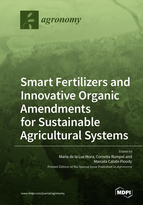Smart Fertilizers and Innovative Organic Amendments for Sustainable Agricultural Systems
A special issue of Agronomy (ISSN 2073-4395). This special issue belongs to the section "Soil and Plant Nutrition".
Deadline for manuscript submissions: closed (20 January 2021) | Viewed by 62204
Special Issue Editors
Interests: Soil; Materials Chemistry; Plant Biology; Soil Fertility; Environmental Science; Soil Analysis; Plant Physiology; Biotechnology; Plant Nutrition; Adsorption
Interests: soil biogeochemistry; soil C sequestration; black carbon; biochar; soil biology; deep soil horizons; organic soil amendments; grassland management
Special Issues, Collections and Topics in MDPI journals
Interests: Environment; Environmental Science; Biotechnology; Environmental Analysis; Environmental Impact Assessment; Plant Biotechnology; Soil Analysis; Water Treatment; Nanomaterials; Soil Fertility
Special Issues, Collections and Topics in MDPI journals
Special Issue Information
Dear Colleagues,
Sustainable agricultural practices are needed to provide food security for a growing global population. Food production is usually associated with high nutrient inputs in the form of mineral fertilisers. Since the beginning of agriculure, such practices have led to soil degradation and the release of environmental contaminants. In this Special Issue, we will focus on innovations in organic and inorganic fertiliser production. We welcome studies concerning new approaches for smart fertiliser development, including bioformulations with mineral particles, nanomaterials, and plant growth promoting microorganisms. We especially encourage authors taking advantage of ecological interactions to improve plant nutrient-use efficiency. Moreover, we would like to include contributions that focus on organic amendments to increase or propitiate the terrestrial C sequestration and stabilization, in order to contribute to mitigating climate change at the same time increasing food security by soil fertility, thus making win–win–win scenarios. Such techniques may concern, but are not limited to, innovative organic waste recycling procedures and new applications of mycorrhizae, rhizobioms, or free living soil bacteria and fungi.
Prof. Dr. Maria de la Luz MoraDr. Cornelia Rumpel
Dr. Marcela Calabi-Floody
Guest Editors
Manuscript Submission Information
Manuscripts should be submitted online at www.mdpi.com by registering and logging in to this website. Once you are registered, click here to go to the submission form. Manuscripts can be submitted until the deadline. All submissions that pass pre-check are peer-reviewed. Accepted papers will be published continuously in the journal (as soon as accepted) and will be listed together on the special issue website. Research articles, review articles as well as short communications are invited. For planned papers, a title and short abstract (about 100 words) can be sent to the Editorial Office for announcement on this website.
Submitted manuscripts should not have been published previously, nor be under consideration for publication elsewhere (except conference proceedings papers). All manuscripts are thoroughly refereed through a single-blind peer-review process. A guide for authors and other relevant information for submission of manuscripts is available on the Instructions for Authors page. Agronomy is an international peer-reviewed open access monthly journal published by MDPI.
Please visit the Instructions for Authors page before submitting a manuscript. The Article Processing Charge (APC) for publication in this open access journal is 2600 CHF (Swiss Francs). Submitted papers should be well formatted and use good English. Authors may use MDPI's English editing service prior to publication or during author revisions.
Keywords
- sustainable agriculture
- ecotechnology
- carbon sequestration
- soil fertility
- waste recycling
- bioformulations
- innovation
- PGPB
- mycorrhizae








